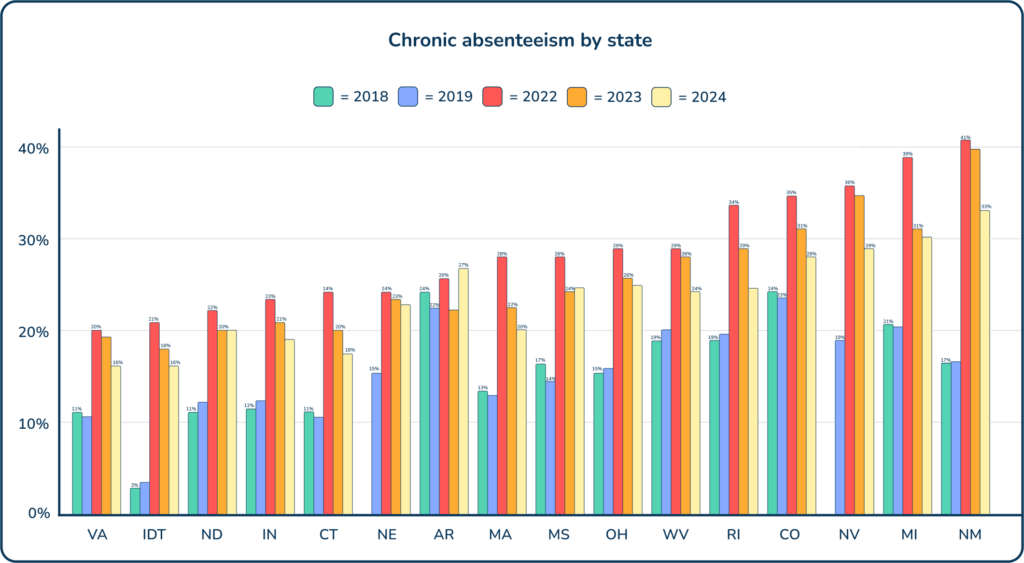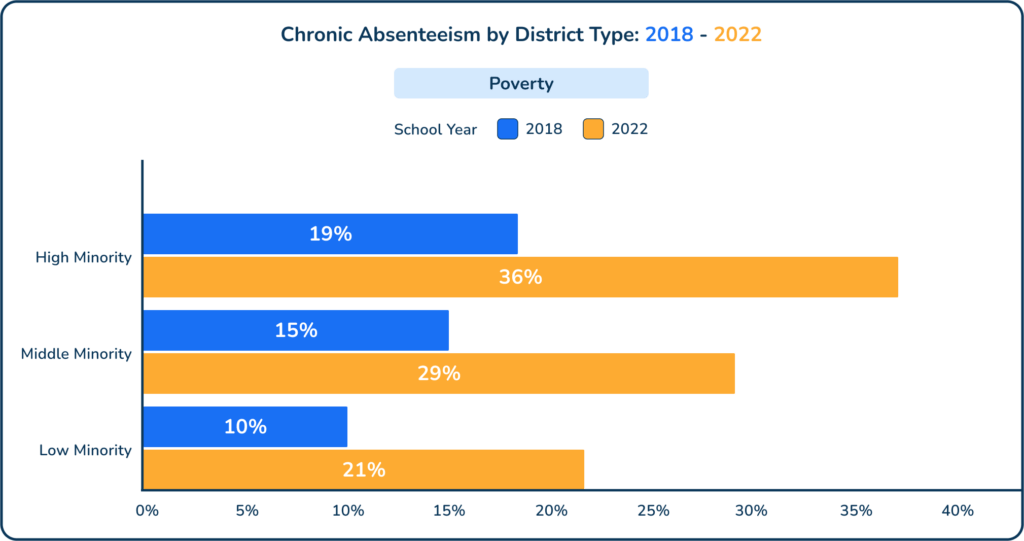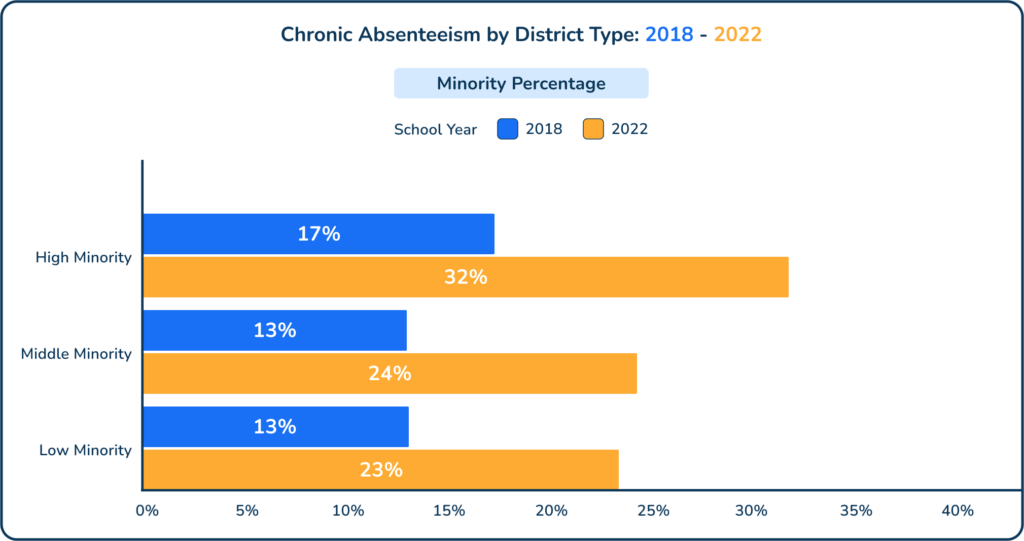Chronic Absenteeism: How Schools And Educators Can Tackle The Problem
Chronic absenteeism is a rising problem in the US. In the 2021-2022 academic year, roughly 14 million US students were classified as chronically absent across elementary school, middle school, and high school.
Although the key to student success is consistent attendance, post-pandemic education has seen rates of chronic absenteeism continue to rise in the United States. The percentage of chronic absenteeism rose from 15% in 2018 before school closures to a staggering 28% of students in 2022 and remained at 26% in 2023¹.
This guide to chronic absenteeism inspects the impact on schools and provides strategies for different stakeholders to help support students and reduce chronic absenteeism.

What is chronic absenteeism?
Chronic absenteeism includes excused and unexcused absences from school. Absenteeism is chronic when a student misses more than 10% of school days in any academic year, regardless of the reason. The exact percentage may vary between public school districts and states but 10% of an academic year equates to roughly 18 to 20 days.
While this number may seem small, the impact of chronic absence can have a profoundly negative outcome on a student’s academic progress and overall well-being.
Supporting Disadvantaged Students to Succeed in Math
This guide contains practical steps for supporting disadvantaged students to succeed in math. Includes practical tips and advice for teachers and school leaders.
Download Free Now!READ MORE: Closing The Achievement Gap
Measurement of chronic absenteeism
The Every Student Succeeds Act (ESSA) from the U.S. department of education, requires states and districts to collect data on chronic absence and publicly report it. This helped highlight how every state’s average chronic absenteeism, apart from Alabama, exceeded the 75th percentile in 2018.
Measuring chronic absenteeism data accurately helps identify trends, implement targeted interventions, and evaluate the effectiveness of school attendance improvement strategies. Many states now use chronic absence data as a measure of school accountability.
At the school level, most schools use Student Information Systems (SIS) to track student attendance, grades, and more. These systems typically generate individualized reports, including absenteeism data.
To further validate school attendance records, many schools implement manual attendance report checks at least twice a school year to verify student enrollment and attendance data for school count.
Attendance reports can help schools better understand chronically absent students. For example, an SIS can identify which absences are excused versus unexcused. These absences are approached differently.
If a student is chronically absent due to illness, there are programs and accommodations many schools can offer to help minimize the impact. Students with excessive unexcused absences require other interventions and face consequences such as suspension.
The most recent NAEP Nations Report Card for 2024 revealed that chronic absenteeism is a continuing post-pandemic problem. While it has improved since 2022, absenteeism is still higher than it was back in 2019.


Impact of chronic absenteeism on students
The negative consequences of students who miss school through chronic absenteeism extend beyond missing class time. Frequently absent students are more likely to:
- Struggle academically;
- Experience difficulty staying on track with their coursework;
- Repeat a grade level;
- Miss critical instruction;
- Lack of social interaction with peers;
- Develop negative attitudes toward school.
Chronic absenteeism is also a strong predictor of students dropping out. One study² found that 25% of chronically absent seniors opted to drop out of high school.

Meet Skye, the voice-based AI tutor making math success possible for every student.
Built by teachers and math experts, Skye uses the same pedagogy, curriculum and lesson structure as our traditional tutoring.
But, with more flexibility and a low cost, schools can scale online math tutoring to support every student who needs it.
Find out moreChronic absenteeism and mental health
In addition to academics, chronic absenteeism can negatively impact students’ mental health and well-being. School often provides a safe and supportive environment for students to develop social skills, build relationships, and learn to manage their emotions. When students are frequently absent, they may struggle to form strong connections with their peers and develop the necessary social coping mechanisms.
Additionally, chronic absenteeism can also lead to feelings of isolation, loneliness, and a sense of disconnection from peers and the school community. This can contribute to low self-esteem, anxiety, and depression.
Factors contributing to chronic absenteeism
A common misconception surrounding chronic absenteeism is that chronically absent students choose not to attend school. While, at times, this is applicable, several factors can contribute to chronic absenteeism, many of which stem beyond a student’s or family’s control.
Socioeconomic factors
Edward Sosu et al.,2018 summarised that socioeconomic status (SES) can contribute to chronic absenteeism and truancy, particularly in students from lower SES backgrounds.
Chronic absenteeism in High-poverty districts saw chronic absenteeism rise 17 points from 19% in 2018 to 36% in 2022. Low-poverty districts only increased 11 points from 10% to 21%.

Students from low-income families may face challenges that hinder a student’s ability to attend school regularly such as:
- Lack of transportation;
- Housing instability;
- Food insecurity.
These factors can create a stressful environment that makes it difficult for students to focus on their education.
Health issues and disabilities
Sometimes, chronic absenteeism results from a complicated medical situation for a student or one of their family members. Health issues can range from chronic health conditions, disabilities, and mental health problems. These situations are common among special education students facing medical concerns.
Students with these conditions may require specialized accommodations or treatment that can interfere with their ability to attend school regularly.
Family dynamics and support
Strained or complicated family dynamics can impact a student’s attendance. Some home situations mean students may face challenges that make it difficult for them to prioritize school.
Unfortunately, it can take time to identify this factor of chronic absenteeism. There is not always a clear answer as to what is going on in a student’s home life and, depending on the situation, students may feel embarrassed to disclose personal information. This can also apply to students with big changes occurring at home including a move, deployed parent, or divorce.
In addition to dynamics, family support also plays a role in student attendance. Students whose families play an active and supportive role in their education are far less likely to be chronically absent than those who do not.
Many families value education but struggle to stay active in their children’s education due to language barriers. Students with parents who do not speak English are often the translators of school-related information, which can be easily skewed if the student chooses, making the parents unaware of the situation.
Districts with a high-minority population saw chronic absenteeism grow 15 points from 17% in 2018 to 32% in 2022. However, chronic absenteeism in districts with a low-minority population grew only 10 points, from 13 to 23%.

Transportation barriers
Lack of reliable transportation can prevent students from getting to school on time or at all. Transportation issues can stem from many places, including:
- Conflicting sibling schedules;
- Parent work schedules;
- Access to transportation.
Access to transportation is particularly problematic for students who live in rural areas or who rely on public transportation that may be unreliable or inaccessible.
Student engagement and motivation
Disengaged or unmotivated learners may be more likely to skip school or arrive late for several factors, including:
- Academic difficulties;
- Lack of interest in school;
- Behavioral problems.
While it may feel optional that these students are skipping school, a negative school or classroom environment can hinder student engagement.
Addressing chronic absenteeism
Tackling chronic absenteeism is a team effort involving schools, families, and their communities. To see a change in a student’s attendance, all parties must be on the same page, which can be difficult depending on the situation.
While intervention at any point is beneficial, the earlier the intervention(s) begin, the sooner the student returns to the classroom and receives the necessary accommodations to succeed.
School-level approaches
Implement attendance policies and procedures
Clear and consistent attendance policies help reinforce the importance of regular attendance. Communicate these policies clearly to students and families.
Before absenteeism becomes chronic, schools could implement a conference in which attendance is addressed and the student and parent/guardian are present.
Create a positive school climate
A supportive and welcoming school environment can foster a sense of belonging and increase student engagement. Schools can create a positive climate and promote positive relationships between students and staff, providing opportunities for students to participate in extracurricular activities, and proudly celebrating student successes.
Provide support services for students
Counseling, tutoring, and other support services can help address underlying issues that may contribute to absenteeism. Schools can also work with community partners to provide additional support services, such as after-school programs and mentoring.
Build relationships with students and families
Strong relationships can identify and address attendance problems early on. Strong and consistent communication helps develop the relationship between students and families, providing opportunities for parents to get involved in their child’s education by understanding school expectations, meeting with faculty, and attending school events.
Community partnerships
Engage with community organizations
Collaborate with local organizations to provide resources and support for students and families. Community organizations could help provide transportation, food, or other resources that can help address the root causes of absenteeism.
Collaborate with local businesses and nonprofits
Businesses and nonprofits can offer mentorship programs, job shadowing opportunities, and other support. These opportunities can help students develop important real-world skills and see the relevance of education to their future careers.
Use resources and services available in the community
Access to community resources such as healthcare, food banks, and transportation can address some of the root causes of absenteeism. Schools can collaborate with community partners to connect students and families with these resources, ensuring discretion.
How educators and families can reduce chronic absenteeism
Educators and families play a vital role in reducing chronic absenteeism. When a student struggles with chronic absenteeism, both parties need strong and consistent communication and collaboration to tackle the issue.
Educators can help identify the root cause(s) of absenteeism by observing and addressing students’ academic and social needs. If an educator notices a student is disengaged, they can implement accommodations to best suit the student’s needs in class.
The goal is to make the classroom, and school, a place the student wants to be, ultimately helping to improve their attendance and engagement in school.
Though the issue is school-focused, families play an essential role in reducing chronic absenteeism by ensuring that their children attend school regularly and providing them with the support they need to succeed. Parents can also work with schools by communicating any underlying issues that may be going on at home that are contributing to their child’s absenteeism.
How Third Space Learning supports learning loss from chronic absenteeism
For over a decade, Third Space Learning has provided one-on-one math tutoring to students struggling to keep up or meet the required math proficiency levels.
Tutoring is delivered by Skye, the AI math tutor built by expert math teachers. Every session is tailored to each student, implementing the instructional strategies and learning strategies students respond to best.
Tutoring programs cover first to eighth grade math standards for the Common Core and state-specific standards, so no matter the state, Third Space Learning’s expertly designed math tutoring can support your students.

Improving student attendance
The number of students who are chronically absent from school, missing 10% or more of the school year regardless of the reason for the absences, is higher now than pre-pandemic.
Chronic absenteeism is a complex issue with far-reaching consequences for student success. But, by understanding the contributing factors to absenteeism and implementing effective strategies, schools, families, and communities can work together to improve student attendance and create a more equitable and supportive learning environment.
Read more on school leadership:
Chronic absenteeism FAQs
What does chronic absenteeism mean?
Chronic absenteeism means a student has missed 10% or more of the yearly school days, whether the absence is excused or unexcused.
How many days is considered excessive absenteeism?
In a 180-day school year, it is considered chronic absenteeism after missing 18-20 or more days of school.
References
- ¹Return to Learn tracker, Chronic Absenteeism
- ²Edward M Sosou et al, 2018, Bera Journals
- The University of Utah, Research Brief, Chronic Absenteeism
Do you have students who need extra support in math?
Skye—our AI math tutor built by experienced teachers—provides students with personalized one-on-one, spoken instruction that helps them master concepts, close skill gaps, and gain confidence.
Since 2013, we’ve delivered over 2 million hours of math lessons to more than 170,000 students, guiding them toward higher math achievement.
Discover how our AI math tutoring can boost student success, or see how our math programs can support your school’s goals:
– 3rd grade tutoring
– 4th grade tutoring
– 5th grade tutoring
– 6th grade tutoring
– 7th grade tutoring
– 8th grade tutoring







